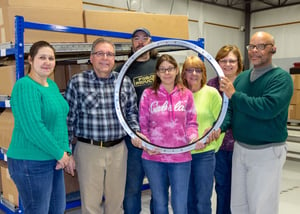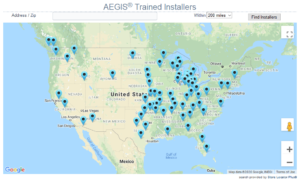Part 7 in a series of questions and answers from our Q&A webinars.
 Q1: What's the largest motor you can use a shaft grounding ring on?
Q1: What's the largest motor you can use a shaft grounding ring on?
A1: There is no size limit. We routinely make AEGIS® rings for turbines over one foot in diameter. The largest ring we've made to date was about 40". A lot of these larger rings get used in power generation: wind, water, and other projects.
The larger the shaft, the heavier we make the ring. We'll upgrade the material to stainless if the application requires a very rigid component.
Q2: You can have different levels of shaft voltage. Are 15V discharges high enough to cause bearing fluting?
A2: Just to be clear: you need an oscilloscope to make these kinds of measurements. That said:
Fifteen volts is more than enough charge to damage the bearing when it arcs. We usually see voltage from zero up to 15-20 volts, and occasionally much higher. But the voltage doesn't tell you the whole story.
You also have to consider the discharge frequency, how many times per second you get arcing through the bearing. If you have 15V discharging a few times per second, that's bad, but the motor won't fail tomorrow. But have you have 15V discharging a few thousand times per second, it's going to fail a lot sooner. (You can get an idea of this by setting the trigger level on the scope. If you set it high and the waveform only updates every few seconds, then you're not having a lot of discharge at that level.)
We like to get the voltage to less than one volt peak. The best way is to measure a baseline, see what it looks like without shaft grounding. Then you use our shaft grounding simulator and test the shaft voltage again to see what it would look like with a grounding ring. Usually, you'll go from 15V down to under one volt. As a rule of thumb, anything up to five volts peak is fine. Once you're down that low, you can be sure the bearing will last for its usual lifetime.
Q3: What contractor would install a grounding ring, if it's not installed by the manufacturer?
A3: You should have it done by whomever is going to do the best job. HVAC, electrical, and facilities/maintenance contractors can do it, and in-house maintenance staff, and so can motor repair contractors. Whoever you have do it, you want to be sure they've got experience.
We have a list of trained installers on our website. It's in a searchable database, so you can find the closest one to you.
Q4: Can shaft voltage create the white etching effect? This is in a polymer extrusion setup, with motors up to 20 MW.
A4: Yes. High shaft current can basically weld the bearing to the shaft. But there may be other causes.
In your case, the first thing to do is take care of the shaft voltage. For a large motor, you want the nondrive end bearing to be insulated. You want a high frequency grounding strap, too. I recommend bonding the strap directly to the grounding ring.
With that taken care of, you can start troubleshooting other possible causes. If you think you have a problem with your gearbox, AEGIS rings can also go on gearbox shafts. Typically you don't need to shaft ground both the motor and the gearbox, but some of our users have done this when they've had a hard time pinning down the problem.
In injection molding, everything in the plant has a way of acquiring a nonconductive coating. So we recommend installing the ring inside the motor, to keep it away from the nonconductive goop that deposits on everything.
AEGIS Rings also come with a 2-year extended warranty against bearing fluting damage. No other form of protection against VFD-caused bearing damage offers a warranty like this.

To learn more about AEGIS shaft grounding and best practices for electrical bearing protection, sign up for a training. We offer monthly live training webinars, and - pandemic restrictions permitting - we can also visit your facility to review your exact application.


